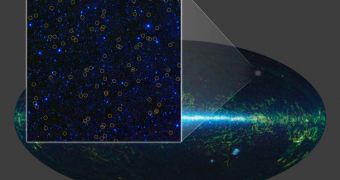Millions of previously-unknown dusty black holes and hot dust-obscured galaxies (DOG) were discovered by the NASA Wide-field Infrared Survey Explorer (WISE) satellite, its team announces.
The supermassive black holes and extreme galaxies were revealed in millions of images the telescope took between 2009 and 2011. During this interval, it completed two full surveys of the entire Universe, in the infrared portion of the electromagnetic spectrum.
Scientists who announced the discoveries say that 1,000+ dusty objects WISE saw could very well be the brightest galaxies ever detected. However, these hot DOG are obscured by large amounts of dust.
All data collected by this telescope – featuring some of the most sensitive infrared detectors ever deployed to space – are made publicly available, so that experts can use them to make new discoveries.
According to the WISE science team, the dataset could be used to gain more insight into how supermassive black holes grow at the core of galaxies. Both the dark behemoths and their hosts control each other’s growth, recent studies indicate.
One of the studies based on information from this telescope identified no less than 2.5 million actively feeding supermassive black holes in the night sky. The most distant were located around 10 billion light-years away from Earth.
“WISE has exposed a menagerie of hidden objects. We've found an asteroid dancing ahead of Earth in its orbit, the coldest star-like orbs known and now, supermassive black holes and galaxies hiding behind cloaks of dust,” WISE program scientist Hashima Hasan says from NASA Headquarters.
Of the 2.5 million black holes found in the study, nearly 1.75 million were not known until now. All of these objects were obscured by massive amounts of cosmic dust. However, WISE can detect the hidden structures by looking for how their accretion processes warm up the material around them.
“We've got the black holes cornered, WISE is finding them across the full sky, while NuSTAR is giving us an entirely new look at their high-energy X-ray light and learning what makes them tick,” says NASA Jet Propulsion Laboratory (JPL) expert Daniel Stern.
He was the lead author of the new paper based on WISE data. Stern holds an appointment as a project scientist for the NASA Nuclear Spectroscopic Telescope Array (NuSTAR), a mission dedicated to studying black holes at X-ray wavelengths.
Details of the three new studies will appear in an upcoming issue of the esteemed Astrophysical Journal.

 14 DAY TRIAL //
14 DAY TRIAL //